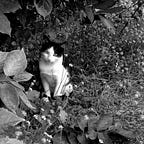Pigments and techniques in Indian miniature paintings
Last month I was fortunate to spend a week learning the basics of Indian miniature painting from Ajay Sharma, a master miniaturist from Jaipur, India.
In this workshop, I transcribed a painting “Peafowl” attributed to the 17th-century Mughal painter Ustad Mansur. To begin with, I first used a very delicate brush made with squirrel hairs and dipped it in black pigments to sketch the outline on a piece of translucent A4 tracing paper. Sometimes the surface of the tracing paper became greasy and repulsed the watery pigments. To overcome this, Ajay taught us a trick: grab a tiny bit of soap nutshell and rub it in the black pigments several times, and the problem was immediately solved.
I then prepared the ground on the handmade wasli paper using a white powdery substance khariya (which I guess means chalk in Urdu), water, and a few drops of gum arabic. The wasli paper was prepared by gluing several layers with adhesive made with flour starch. I then burnished the ground with an agate, applied the base colour, and burnished again.
The next step was to sandwich a piece of carbon between the sketch and the wasli paper and transferred the outline onto the burnished ground using a pen. I then used the black pigments to trace the contour, filled in with mineral pigment colours and did some washes.
I then retraced the outline of the peafowl using the black pigments. Ajay was extraordinarily patient and helpful at each step, and meticulously corrected the numerous mistakes I made. Finally, Ajay helped me with drawing straight borderlines khat (which, again I guess, means letter, lettering, handwriting, or a line in Urdu) using a brush which I was not very good at, as well as laying down the margin of the miniature painting.
Ajay said the main ingredient of the black pigment came from soot, and I think it was the carbonised matter from burning the kerosine lamps. I prepared the black pigment by mixing it in a shell with gum arabic and water until it became dry. At this point, the inner surface of the seashell looked as if a shiny black polish covered it, and can immediately dissolve when touched by a wet brush.
And we mixed every colour with our fingers.
Today while reading Daniel V. Thompson’s The Materials and Techniques of Medieval Paintings, which devotes an entire chapter to pigments, I discovered a similarity between the medieval lampblack and Ajay’s black pigments. They are more or less the same stuff:
One black pigment, lampblack, was often made into an ink by mixing it with gum. Lampblack was made in the Middle Ages by allowing a flame to play on a cold surface and collecting the soot which the flame deposited…One great beauty of lampblack…is that it is extremely fine in grain, and does not need to be made finer by grinding.
But he also mentioned its drawback:
It is apt to be a little greasy, hard to mix with water or water media, and so light that the powder floats in the air and tends to go where it is not wanted. The colour, too, though excellent for pure blacks, is apt to be a little muddy in mixtures.
From what I observed, Ajay used this black pigment to draw the figures’ hairs. And for me, this black pigment was not greasy at all and was readily mixable with water.
It is beyond words to describe how beautiful the colours from natural mineral pigments are on the surface of the painting. The smooth, pearlescent texture from burnishing is unlike anything I have seen in other kinds of painting tradition. Some oil paintings, like the ones from Georgia O’Keeffe, do have a pearlescent appearance, but the physicality is different with an added illusion of dimensionality. It is a pity how the knowledge of mineral pigments is gradually lost. Perhaps it is time to revive the culture, once again, in the hands of the Indian miniature painters.
